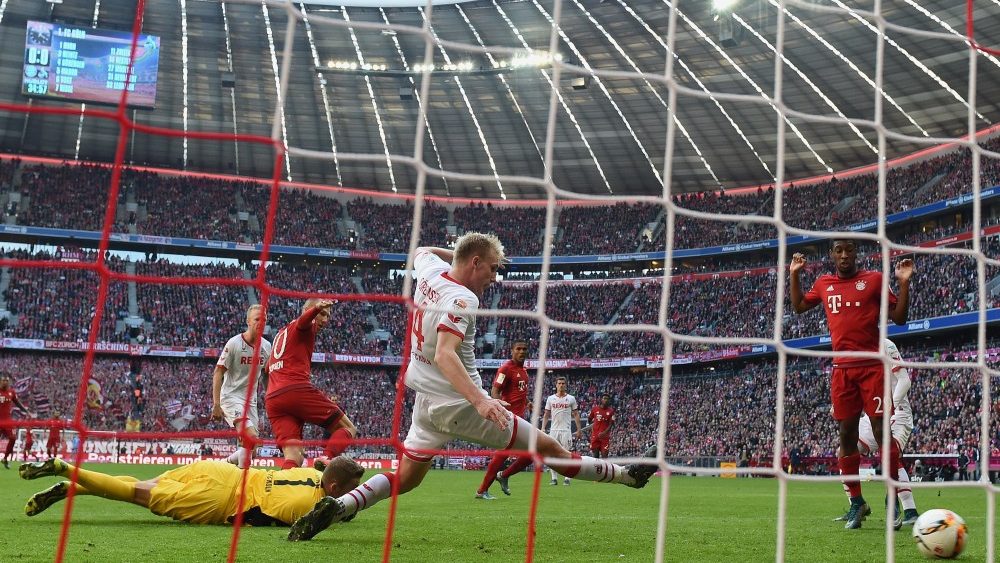Match Analysis: FC Bayern München – 1. FC Köln 4-0 (2-0)
Entering the match, Bayern’s all-time Bundesliga record included an impressive 999 wins. This was the first opportunity to get that historical win number 1000.
 Bayern in a 2-3-4-1 system, trying to find holes in Köln’s 5-4-1 wall.
Bayern in a 2-3-4-1 system, trying to find holes in Köln’s 5-4-1 wall.Three things we noticed:
1. Overloading the edge of the box
Against Arsenal and Bremen, the Bavarians had serious issues to create scoring chances. Many good ideas didn’t turn into anything useful, possession was wasted. Pep Guardiola expected Köln to line up in a similarly defensive-minded matter and – unlike on Tuesday – took risks. The starting lineup included five attacking players. The offensive positioning of Müller and Robben was supposed to reduce the problem of playing the ball around the box without entering it. Both tried to position themselves between the lines, at first with limited success. It wasn’t until Douglas Costa moved to the center, using his quality and pace to exert pressure, that the guests made big mistakes. Bayern showed patience, completing 357 of 400 passes in the attacking third – impressive numbers.
Another big advantage of the attacking five was the flexibility. They constantly switched positions, occasionally overloading the center and further on the wings. Köln’s defensive shift struggled to keep up, often failing to adjust in time. Naturally, that allowed Bayern to create more scoring chances – 26 shots in 90 minutes.
2. Vidal isn’t Alonso
Arturo Vidal was the main figure in the Bayern buildup. He reached a personal Bundesliga high with 147 touches. That being said, his struggles to direct the Bayern game were obvious in the opening minutes. Vidal misplaced lots of passes, displaying a degree of inaccuracy that the central midfield hasn’t seen from Xabi Alonso. He recorded a solid passing accuracy of 91,5% but, compared to the average accuracy of central midfielders in the Guardiola system, it’s actually a little low. Another good indicator are his long balls. Only one of them was completed – and merely three attempted. In other words: Vidal misplaced 12 passes, many of them in the attacking third. His transitional defense was inconsistent. Vidal only won 11% of his tackles.
Nevertheless, he added quality to the Bayern game, as one number demonstrates: Vidal registered five shots, the second-most of any player. He continuously pushed forward, willing to shoot. Just look at the 2-0. He gives the team an unpredictability by providing a goal threat from midfield. Lahm, Thiago and Alonso are anything but natural goalscorers. Against an ultra-defensive opponent, a vertical midfield with scoring intentions is key. It’s no coincidence that Vidal scored against Darmstadt and Köln, two highly passive teams.
3. “I don’t care about counters”
Pep Guardiola took risks. The starting lineup was so offensive-minded that Köln were basically begged to go for counter-attacks. They had several attacking situations at even strength but didn’t operate accurately enough. Although Modeste did a good job to keep the ball against Boateng and Rafinha/Alaba, the supporting wave from midfield was too wide with a positioning that left a lot to be desired. Tons of counter-attacks ultimately were wasted on weak crosses and offside positions. Köln seemed too overhasty. Only 33 of 64 passes in the attacking third were completed, certainly not enough to threaten the hosts. Furthermore they only took four shots, three of them from outside the box.
Bayern on the other hand accepted the risk of conceding a goal, knowing that their own offense will create enough chances to win the match. The high positioning of Robben and Müller in addition to the attacking-minded Vidal caused the spaces between defense and midfield and between midfield and offense to be rather big. Köln didn’t know how to exploit that. Once again, Pep Guardiola was right to choose such an attacking system.
| FC BAYERN – 1. FC KÖLN 4-0 (2-0) | |
|---|---|
| FC Bayern | Neuer – Lahm, Boateng (62. Martínez), Alaba, Rafinha – Vidal – Coman, Robben (65. Kimmich), Müller (78. Thiago), Costa – Lewandowski |
| Subs | Ulreich, Bernat, Kirchhoff, Alonso |
| 1. FC Köln | Horn – Sörensen, Maroh, Heintz – Risse, Lehmann, Vogt, Hector – Zoller (71. Hosiner), Modeste (58. Osako), Gerhardt (75. Svento) |
| Subs | 1:0 Robben (35.), 2:0 Vidal (40.), 3:0 Lewandowski (62.), 4:0 Müller (77./Foulelfmeter) |
| Cards | Yellow: Rafinha / Lehmann |
| Referee | Florian Meyer (Burgdorf) |
| Attendance | 75.000 (sold out) |












I completly agree with what I read. Although I believe that when Müller was replaced by Kimmich, Vidal took a position where he is not as useful as in the middle. Again I must say this article is marvelous and thanks for sharing it!
I wouldn’t say that he was not in a useful position. He played the Alonso role well, but as I mentioned — in a different way. With his personal strength and weaknesses. His weakness is clear – he lost to many balls for a central midfielder. Therefore he had many scoring chances and opportunities. Vidal went often into the box. For example at the second goal – this extra yardage isn’t the style of playing from Alonso. But this helped against the very defensiv operating FC Cologne.